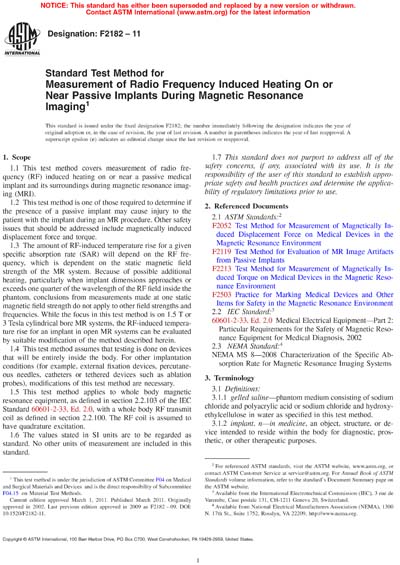Historical
ASTM F2182-11
Standard Test Method for Measurement of Radio Frequency Induced Heating Near Passive Implants During Magnetic Resonance Imaging
1.1 This test method covers measurement of radio frequency (RF) induced heating on or near a passive medical implant and its surroundings during magnetic resonance imaging (MRI).
1.2 This test method is one of those required to determine if the presence of a passive implant may cause injury to the patient with the implant during an MR procedure. Other safety issues that should be addressed include magnetically induced displacement force and torque.
1.3 The amount of RF-induced temperature rise for a given specific absorption rate (SAR) will depend on the RF frequency, which is dependent on the static magnetic field strength of the MR system. Because of possible additional heating, particularly when implant dimensions approaches or exceeds one quarter of the wavelength of the RF field inside the phantom, conclusions from measurements made at one static magnetic field strength do not apply to other field strengths and frequencies. While the focus in this test method is on 1.5 T or 3 Tesla cylindrical bore MR systems, the RF-induced temperature rise for an implant in open MR systems can be evaluated by suitable modification of the method described herein.
1.4 This test method assumes that testing is done on devices that will be entirely inside the body. For other implantation conditions (for example, external fixation devices, percutaneous needles, catheters or tethered devices such as ablation probes), modifications of this test method are necessary.
1.5 This test method applies to whole body magnetic resonance equipment, as defined in section 2.2.103 of the IEC Standard 60601-2-33, Ed. 2.0, with a whole body RF transmit coil as defined in section 2.2.100. The RF coil is assumed to have quadrature excitation.
1.6 The values stated in SI units are to be regarded as standard. No other units of measurement are included in this standard.
1.7 This standard does not purport to address all of the safety concerns, if any, associated with its use. It is the responsibility of the user of this standard to establish appropriate safety and health practices and determine the applicability of regulatory limitations prior to use.
Content Provider
ASTM International [astm]






